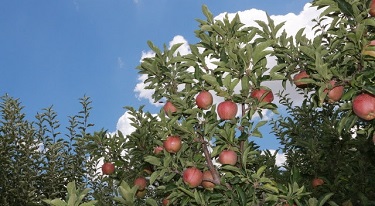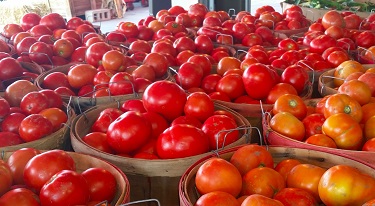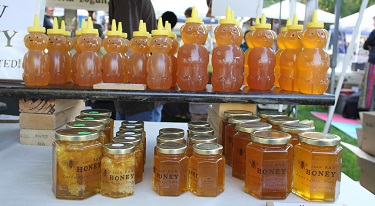Moab Local Food Guide 2024
Those growing and producing food within a 100 mile radius from Moab have been included in this guide to help YOU make locally sourced purchasing decisions!

Is it better to buy local or to change the types of foods we are eating? What is a CSA? Find answers to these questions and more by browsing this page

Those growing and producing food within a 100 mile radius from Moab have been included in this guide to help YOU make locally sourced purchasing decisions!
Utah’s farmers markets reside and operate on the territories of the eight tribes of Utah, who have been living, working, and residing on this land from time immemorial. These tribes are the Confederated Tribes of the Goshute Indians, Navajo Nation, Ute In...
Moab Grown partners local farmers and producers with our community chefs and retail outlets. This one-page document highlights Moab Grown’s 2023 impacts.
With proper care, management, and harvesting, backyard beekeeping can provide health, economic, and environmental benefits.
Beef is part of American culture, so is there a way to make wiser choices when it comes to purchasing beef? The short answer is, yes!
Beneficial insects & other natural enemies identification guide
Community agriculture initiatives are often run by organizations (1) relying on volunteer structures; (2) growing produce sustainably; and (3) aiming to improve health and access to food in their communities.
As interest in home gardening and self-sufficiency surged during the pandemic, many are looking for ways to preserve foods from their newfound harvests. This fact sheet provides an overview of how to build a community solar food dehydrator for food preser...
To evaluate the impacts of CSA program and benefits of local foods, this fact sheet provides an overview of the advantages of CSA programs as they relate to supporting economic, social and ecological sustainability.
The U.S. Department of Agriculture’s Food and Nutrition Service (USDA FNS) authorizes businesses to accept SNAP benefits, including direct marketing farmers and nonprofit food buying cooperatives operating a CSA.
This fact sheet will help you learn more about the components of an effective crop plan and how to use one in your CSA operation.
Community Supported Agriculture (CSA) provides a direct connection between local community members and growers, generally through purchasing a weekly “share” of locally grown goods provided by the grower throughout a time frame.
As with all businesses, Community Supported Agriculture (CSA) growers may experience legal concerns. This fact sheet will walk growers through certain steps that may be taken to minimize the liability of your CSA operation and manage possible risks.
When you market your community supported agriculture (CSA) operation, you should consider the best communication tools to delivering information to potential and current shareholders, engaging your shareholders, and getting feedback.
CSA members are offered fresh, locally grown goods and an opportunity to support local farms and farmers by investing in a CSA share from a local grower.
This information can help you through the financial process by explaining how to develop a budget, how to price your CSA share with different pricing strategies, and payment policy.
Starting a Community Supported Agriculture (CSA) operation requires planning and consideration. The method and process of your CSA operation must be determined, as well as how to properly record and finance the operation.
This packet includes all the information you need to successfully implement, and evaluate Create Farm Fresh Food classes.
This guide’s steps were compiled during background research for advertising acceptance of SNAP benefits using Electronic Benefits Transfer (EBT) cards and the Double Up Food Bucks (Double Up) program offered at farmers markets throughout Utah.
This publication examines Utah farmers’ market consumer preferences for organically grown and local fresh produce and their willingness to pay premiums for labeled products by production method and origin.
A Guide for Growers and Extension Educators.
This fact sheet provides a set of quick facts and action tools to make educated choices concerning one major purchasing choice for many: meat.
A Guide to Vegetative Propagation of Native Woody Plants in Utah
This fact sheet provides communities and individuals with general urban gardening information about: Common contaminants that can be found in urban soil. Ways to identify contaminants and reduce exposure. Improving soils and growing plants in mildly conta...
Researchers at Utah State University are exploring the use of tannin-containing legumes as a method for finishing cattle to address environmental and efficiency concerns associated with the most common current beef production systems.
This resource includes information about starting seedlings outdoors and materials for success, knowing when to plant, sowing seeds, seed germination, and more!
Eating locally means minimizing the distance between production and consumption, especially in relation to the modern mainstream food system.
A Quick Guide to Home Vegetable Gardening
This gives you key information regarding the resources that are available to the bees during certain times of the year and if supplementation of food and resources may be necessary.
Urban foraging is the art of finding, identifying and collecting wild edibles in everyday urban settings.
If you can’t beat them, eat them! Increase your garden’s yield by identifying the edible weeds and adding them to your harvest.
This toolkit outlines how farmers markets can implement a SNAP program, and help combat food insecurity in their communities.
Find a farmers market near you.
This book is a compilation of 58 researched-based fact sheets written and compiled by Utah State University faculty and students.
View the latest issue of the guide along with an archive of previous issues.
View Guide
Jeff Adams from Terrasophia LLC shows strategies for permaculture and climate resiliency on both a small and large scale.
Jeremy Lynch gives a tour of the permaculture garden on the USU Moab Campus.
Do you want to produce specific behavioral changes within your community?
This comprehensive overview of local food systems explores alternative definitions of local food, estimates market size and reach, describes the characteristics of local consumers and producers, and examines early indications of the economic and health im...
IN THIS ISSUE: Food Insecurity in the Western States; Understanding Farm Worker Food (in)Security in California; Rural Collaboration Works to Build Higher Skill Levels; Food Insecurity and Stress Among Children in the Western U.S.; Farm to School; Marketi...
IN THIS ISSUE: A Food Hub Challenge; Clarifying the Regional Food Hub Challenge; The Final Frontier: A farmer's perspective; Economic Implications of Farm to School for a Rural Colorado Community; Land Use Planning and Spatial Configuration Benefit Commun...
This report provides an overview of local and regional food systems across several dimensions.
Highlights from the year for the USU Permaculture Initiative.





